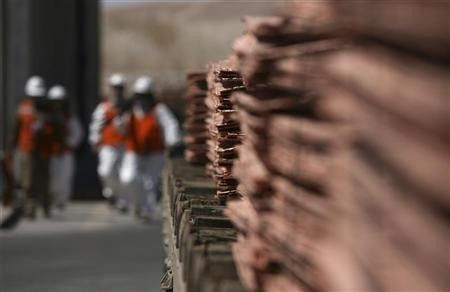Bullish scenario for copper: rising demand, tightening supply

Although it might lack the glamour of more heralded commodities like oil and gold, copper is a crucial component of industry and technology and its price typically reflects the health of the underlying global economy.
Copper has a multitude of uses -- everything from electrical wires to plumbing pipes to heating applications to automobiles to air conditioners. Thus, it is indispensable for any highly industrialized society.
Having just touched an all-time high in price, demand for the red metal is expected to be very strong in the coming years, driven primarily by China’s insatiable hunger for commodities of all kinds to support its relentless program of mass urbanization. Also, the anticipated emergence of a handful of copper-related exchange-traded funds (ETFs) will also push up demand.
Meanwhile, copper supplies are under pressure for a variety of reasons – including falling ore grades at the older copper mines, the likelihood of labor unrest at mining facilities and a paucity of new discoveries -- thereby creating a supply-demand profile that favors long-term price appreciation.
Indeed, on the New York Mercantile Exchange, copper futures for March delivery closed at $4.10 per pound on Wednesday, a new all-time settlement high (although this figure remains below the all-time highest traded price of $4.24 established on May 5, 2008).
Copper prices have jumped more than 20 percent year-to-date. Since the lows of early June, the spot price has spiked about 45 percent.
Copper has also benefited from the new tax-cut extensions in the U.S., a measure that is expected to add to American economic growth next year.
“The biggest single factor behind the rise in copper prices is China,” said Bart Melek, global commodity strategist at BMO Capital Markets in Toronto.
“China alone presently accounts about 40 percent of global copper consumption and we believe demand there will continue to be strong, further supporting a rise in copper prices. China has very little copper of its own.”
While some observers are concerned about China’s plans to cool down its economy by raising interest rates, among other measures, Melek doesn’t think this will hurt copper demand.
“Even if China’s economic growth moderates somewhat next year, that will not be significant enough to materially impact copper demand,” he stated.
“Moreover, much of the inflation witnessed recently in China has been caused by rising food prices.
Thus, since China is inexorably committed to urbanization/development, its demand for crucial commodities like copper is likely to continue unabated. For example, the country's ambitious plan to upgrade its electric power grid will require an enormous amount of copper.
These are mandated expenditures that are immune to any changes in monetary policy, Melek noted.
Outside of China, a sustained recovery in other nations, as well as a rebound in copper-dependent industries like the automotive sector, will further pump up demand for the metal.
Melek is forecasting a 7.8 percent rise in copper demand this year, followed by another 6 percent gain in 2011.
Plus, as supply tightens, leading to what Melek characterizes as a hefty deficit in 2011, the pricing picture becomes even brighter.
Melek estimates that on an average annual basis, the price of copper will ascend to $3.90 per pound in 2011, up from $3.30 this year.
To underscore the concern that the markets have about copper scarcity, consider that last week the British newspaper Daily Telegraph reported that a mystery buyer had acquired more than $1 billion of physical copper, representing more than 50 percent of all the metal stored in official London warehouses. It was subsequently reported that the mysterious buyer was none other than U.S. banking giant J.P. Morgan Chase & Co. (NYSE: JPM).
While this action does not quite constitute cornering the market, it suggests how a handful of major players taking aggressive positions in the copper market (as well as certain other commodities like nickel and aluminum alloy). The Wall Street Journal reported that J.P. Morgan said it purchased the copper mostly on behalf of clients.
Incidentally, the London Metal Exchange said that its warehouses currently hold about 350,000 tons of copper, down from 555,000 in February. Copper stockpiles have been in sharp decline all year, on schedule for the first annual drop since 2004.
Melek, who declined to specifically on JP Morgan, indicated that with a number of new ETFs coming on-stream, they will need to acquire a substantial amount of the physical metal in storage. (Indeed, JP Morgan is planning its own copper ETF for next year).
They might pay a risk premium to guarantee deliver if they're worried about availability, he said.
© Copyright IBTimes 2024. All rights reserved.





















